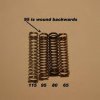The diaphragm should be comparably soft as a rose petal, slightly stiffer. And holding it up to light there should be no holes.
As the diaphragma age, they can develop holes or the neoprene stiffens to become inflexible.
Aftermarket diaphragms often have the incorrect length metal nipple on them so too long will strike the metering arm too early holding the metering needle open or too short won't lift the needle. Many consider the aftermarket material too thick and stiff, I agree.
Recommended pop varies largely with airbox design, if the factory manual calls for 22~25 you're close enough, shoot to make both carbs equal.
It's important to start with the correct spring. Working with the incorrect spring can result in a oddly shaped lever arm or inability to reach pop spec even by mangling the arm to odd shapes. New arms are available and may need slight adjustment, but certainly not need to be mangled.
There are four different springs available for these Mikuni diaphragm carbs, and to make things really tricked out, occasionally spacers. To select the correct spring strength, the color is matched to the Seadoo factory specified strength in grams. Mikuni part numbers are on the right, I don't know the seadoo numbers, as through the years various superseding numbers were assigned for the same part by Seadoo seemingly at random.
The seat orifice diameter also plays a part in pop-off, the smaller diameter will result in higher pressure required to pop and smaller diameter than specified can cause lack of fuel at WOT. Too large of diameter and they leak from vibration at idle. Therefore, it's important to use the correct diameter seat orifice for your application (as important as selecting the specified spring)
Hopefully I'm not confusing you...








